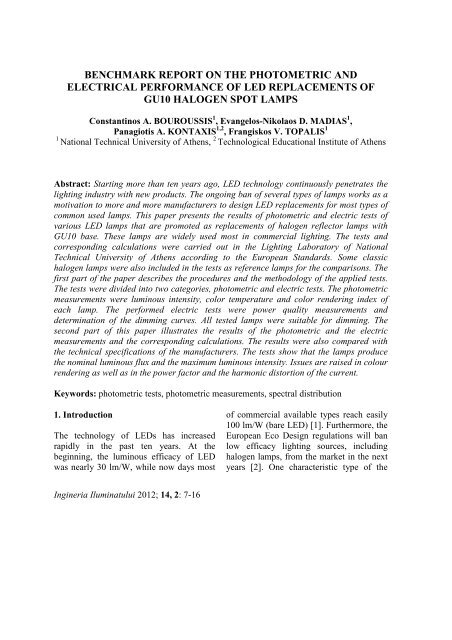Untitled - Journal of Lighting Engineering
Untitled - Journal of Lighting Engineering
Untitled - Journal of Lighting Engineering
Create successful ePaper yourself
Turn your PDF publications into a flip-book with our unique Google optimized e-Paper software.
BENCHMARK REPORT ON THE PHOTOMETRIC AND<br />
ELECTRICAL PERFORMANCE OF LED REPLACEMENTS OF<br />
GU10 HALOGEN SPOT LAMPS<br />
Constantinos A. BOUROUSSIS 1 , Evangelos-Nikolaos D. MADIAS 1 ,<br />
Panagiotis A. KONTAXIS 1,2 , Frangiskos V. TOPALIS 1<br />
1 National Technical University <strong>of</strong> Athens, 2 Technological Educational Institute <strong>of</strong> Athens<br />
Abstract: Starting more than ten years ago, LED technology continuously penetrates the<br />
lighting industry with new products. The ongoing ban <strong>of</strong> several types <strong>of</strong> lamps works as a<br />
motivation to more and more manufacturers to design LED replacements for most types <strong>of</strong><br />
common used lamps. This paper presents the results <strong>of</strong> photometric and electric tests <strong>of</strong><br />
various LED lamps that are promoted as replacements <strong>of</strong> halogen reflector lamps with<br />
GU10 base. These lamps are widely used most in commercial lighting. The tests and<br />
corresponding calculations were carried out in the <strong>Lighting</strong> Laboratory <strong>of</strong> National<br />
Technical University <strong>of</strong> Athens according to the European Standards. Some classic<br />
halogen lamps were also included in the tests as reference lamps for the comparisons. The<br />
first part <strong>of</strong> the paper describes the procedures and the methodology <strong>of</strong> the applied tests.<br />
The tests were divided into two categories, photometric and electric tests. The photometric<br />
measurements were luminous intensity, color temperature and color rendering index <strong>of</strong><br />
each lamp. The performed electric tests were power quality measurements and<br />
determination <strong>of</strong> the dimming curves. All tested lamps were suitable for dimming. The<br />
second part <strong>of</strong> this paper illustrates the results <strong>of</strong> the photometric and the electric<br />
measurements and the corresponding calculations. The results were also compared with<br />
the technical specifications <strong>of</strong> the manufacturers. The tests show that the lamps produce<br />
the nominal luminous flux and the maximum luminous intensity. Issues are raised in colour<br />
rendering as well as in the power factor and the harmonic distortion <strong>of</strong> the current.<br />
Keywords: photometric tests, photometric measurements, spectral distribution<br />
1. Introduction<br />
The technology <strong>of</strong> LEDs has increased<br />
rapidly in the past ten years. At the<br />
beginning, the luminous efficacy <strong>of</strong> LED<br />
was nearly 30 lm/W, while now days most<br />
Ingineria Iluminatului 2012; 14, 2: 7-16<br />
<strong>of</strong> commercial available types reach easily<br />
100 lm/W (bare LED) [1]. Furthermore, the<br />
European Eco Design regulations will ban<br />
low efficacy lighting sources, including<br />
halogen lamps, from the market in the next<br />
years [2]. One characteristic type <strong>of</strong> the
















